

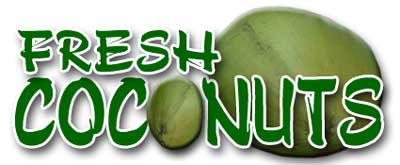
Q: How many different types of coconut trees are there? And do all palm trees grow coconuts?
A: To answer the second question first, NO not all palm trees grow coconuts. There are several types of palm trees that grow a wide range of different types of coconuts in most all parts of the world.
As of 2018, the countries that export the largest amount of coconuts are Indonesia, Thailand, Vietnam, Malaysia, the Netherlands, Mexico, Guyana, and India. These countries make up approximately 85% of the world’s consumption of coconuts.
Out of all the palm trees, there are only two types of Cocos Nucifera Coconut Palms that grow coconuts. They include the Tall- tree and the Dwarf varieties and grow 11 different types of coconuts. These coconuts usually are either green, orange or brown.
The green coconut is the most popular, but the orange contains more coconut water. Besides that, they both taste the same. The brown coconut was either green or orange, but ultimately turned brown after aging for about 30 days..
These are the Different Types of Coconut Trees.
Explanation of different types of Coconut Trees and Palm Trees..
There are two types of coconut trees. A three-year-old coconut tree and six-year-old coconut tree..
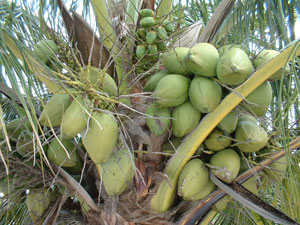
The six-year coconut tree, which produces fruit in about six years, is slower growing and is less common. Y
You can easily distinguish between the two, as the three-year coconut tree does not have a bulb at the base of the trunk, which is characteristic of the six-year coconut tree..
Two Different Colors of Coconuts Come From Many Types of Palm Trees
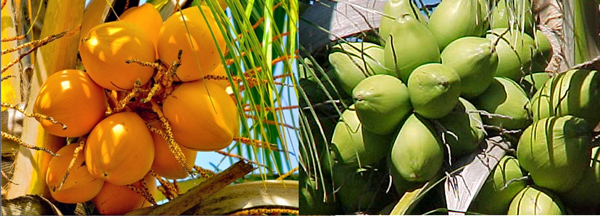
The three-year coconut tree leaves are more uniform in shape, being as slender at the base of the leaf, up to about four to five inches from the tapering tip.
The six-year coconut tree, however, has a larger leaf at the bottom and tapers slightly through the leaf up until the tip.
There are definite differences of varieties between the six-year and three-year trees.
Also, there are two different colors of coconuts.
There is a green variety, and then there is the red/orange type. Now, on Guam, there are about seven different types of coconut trees.
Himalayan Mountain Fishtail (Caryota Maxima)
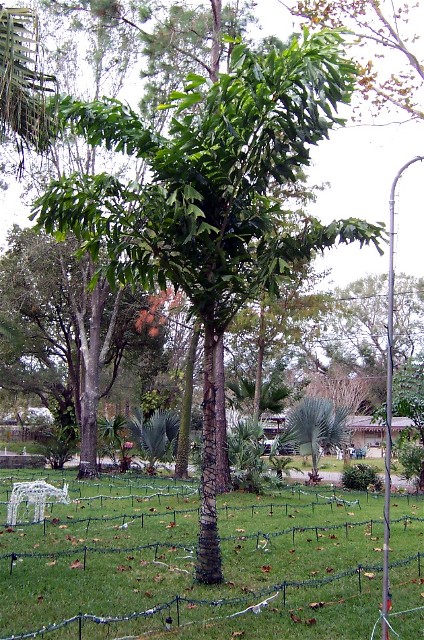
Easy to see in the display, this Fishtail Palm is known as the Himalayan Mountain Fishtail. It is widely known in California as the Mountain Fishtail and can easily grow over 6 feet per year, and is frequently only seen in the outdoor woods and forests.
Reports are that this palm can survive temperatures of 7 degrees above zero, and some people in London, England, successfully grow this palm outdoors year-round. The most cold-hardy of all fishtail palms, this one comes from mountainsides subject to annual snowfall and is part of the Caryota Maxima family.
It is both vigorous and beautiful, but is extremely shy to homeowners, gardens, and landscapers due to its strong ability to prosper best in the wild in extreme cold weather.
More information on this tree at: https://en.wikipedia.org/wiki/Bismarckia
Teddy Bear Palm (Dypsis Latifolia)
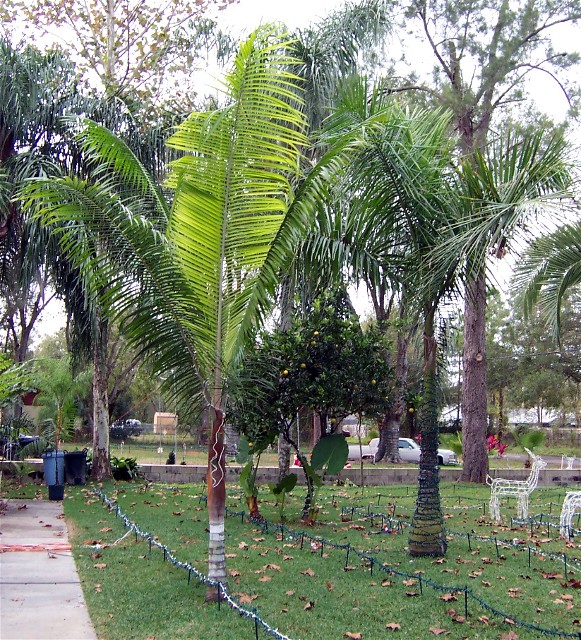
To the left with the white trunk is our Teddy Bear Palm (Dypsis Latifolia). This palm has a strong resemblance to a coconut palm; however, unlike coconuts, this palm can tolerate endless nights of 30 and 40-degree weather without being killed. To the right is a genuine Cuban Royal Palm, taken from seed harvested in the Sierra Madre Mountains of central Cuba in the year 2000.
***You can buy Teddy Bear Palm seeds here: https://plantflowerseeds.com/products/dypsis-leptocheilos-teddy-bear-palm-5-seeds
Foxtail Palm
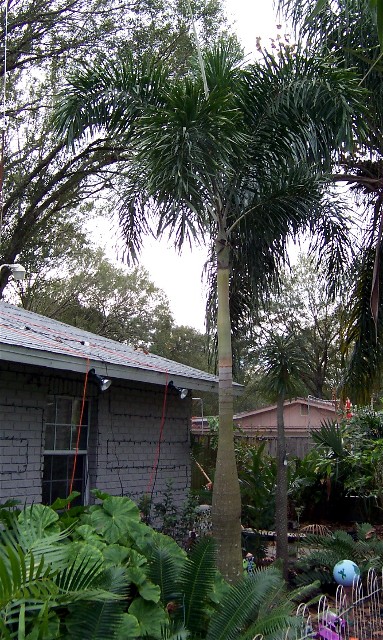
Above is a Foxtail Palm Tree. This palm was started from seed in 1999 and has grown higher than the house behind it. This palm is nearing the age where it may begin setting its own seed soon.
Flowering: White flowers stalk that comes from the base of the crownshaft.[4]
Foliage: Variance of greenish colors; deep green to light green colors. Received its more commonly known Australian-English name from the appearance of its foliage, which is in a shape of a fox’s tail.[4]
Fruits: 2 inches long. Olive green to green in the early stages. Orange red when ripe.[4]
Trunk: Similar to the king palm, the foxtail palm trunk is smooth, thin, and self-cleaning. It grows a single, double, or triple trunk that is slightly spindle-shaped to columnar reaching heights of about 30 ft. The trunk also has a closely ringed, dark grey to light gray color which slowly turns more and more white. The crownshaft of the foxtail palm is light to bright green and slightly swollen at the base.[4]
Chameadorea Tepejote
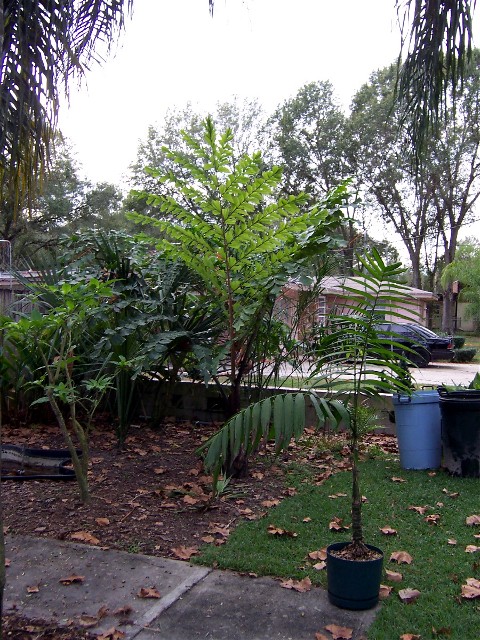
In the pot is a Chamaedorea tepejote. This palm is basically a giant parlor palm and comes from the high Andes Mountains of Colombia. This palm natively grows in the same areas that coca grows, a plant that cocaine and Coca Cola Classic are made from; however, unlike most Colombian mountain palms or coca, this palm thrives in Florida’s sea level altitudes, and it even grows better in the cooler winter days as opposed to summer. Behind this palm is a Laosensis Giant Fishtail, and near that is a very very rare Dypsis Olyenhensis. Not too far from here is also a Sabal Palm from Puerto Rico.
This is where you can buy seeds to grow this plant:
https://letsgrowflorida.com/products/chamaedorea-tepejilote-palm-tree-2
Phoenix Rupicola Palm Tree
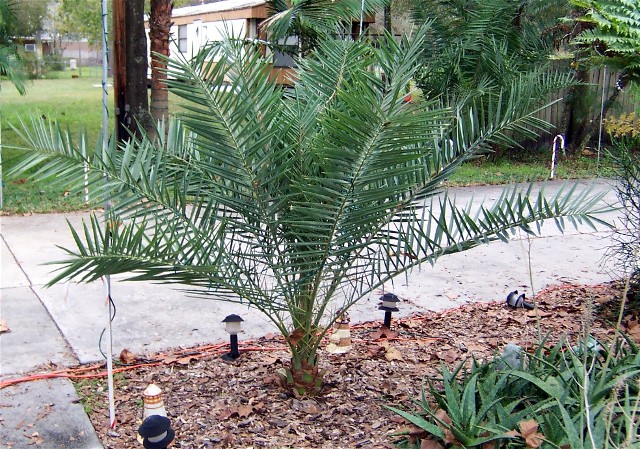
Along the Christmas Light Trail near the front sidewalk of the house is a dwarf date palm called Phoenix Rupicola Palm Tree. This date palm is best described as a miniature Canary Island Date Palm. This palm is very well suited for central Florida however, it is rarely ever seen.
The Phoenix rupicola is a very graceful palm that can grow in both cold and hot regions. It is one of the easiest to grow Phoenix Palms and has a much neater and cleaner appearance.
Phoenix rupicola palm trees develop to 8 meters (26 ft) in tallness, and 20 cm in width. They are generally spotless on leaf bases with the exception of close to the crown.
You can purchase a full-grown tree here: https://khizranursery.com/hardy-palms/phoenix-rupicola/
King Palm family (archontophoenix)
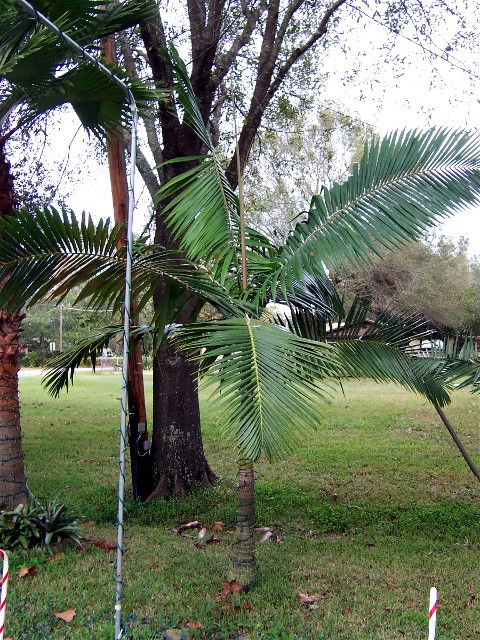
This is a Pincushion Palm Tree. A proud member of the King Palm family (archontophoenix). This palm is one of the more cold-hardy King Palms and is older than 45,000 originating from Australia.
This tree’s flower color is usually a pretty purple or violet. The potent, pleasant fruits and red in color and attractive to all types of birds and critters. It usually flowers in late summer and has bright green leaves.
This palm tree is also known as the Illawara palm, Bangalow Palm, King Palm, and the Piccabeen Piccabeen.
Piccabean Palm or ( Piccabeen / Archontophoenix )

Even rarer than the Piccabean Palm above, this palm tree is one of 5 “purple piccabean” palms on the property. If you look carefully, the trunk/crownshaft of this palm is a bright, vivid violet or “purple”.
The Piccabeen is a beautiful tree that is native to South Florida and is one of the most popular among landscapers. It is both very tolerant of the extreme heat of the summer and the extreme cold of South Florida, making it a very robust plant.
It grows to about 30 feet tall at a pretty slow rate and does not require a lot and care, growing or watering. It is a very low-maintenance plant and reflects the best of Florida.
This Palm tree is also known as the Bangalow Palm, Bungalow Palm, King Palm, the King Alexander Palm (Archontophoenix Alexandrae)
(Purchase Coconuts. They Will Grow If You Plant Them Properly)
Carpentaria Palm or Carpentaria Acuminata

The banana-looking plant that Frosty (in the picture) is looking at is a Madagascarian Traveler’s Palm. Just to the left is a Carpentaria Palm. The carpentaria palm is from Australia and is known as a pencil-pointing palm in that part of the world because it is very narrow at its growing point.
To the right of Frosty the Snowman is a low-growing palm is a Dypsis Cabadae palm. It is very similar to the golden crown shaft palms known as Areca Palms, however, this one is red in color. This has become “extinct” in its country of origin, Madagascar. Supposedly, fewer than 200 specimens of this palm exist in the world.
The Carpentaria Palm is very popular around the world and is one of the best palm trees for utilizing the palm leaves that grow to about 60 inches by 36 inches. In the past, the leaves were used by native Americans for cooking and wrapping food for smoking.
Native to Australia’s Northern Territory, it commonly grows close to water due to its tropical thirst for water and is very in love with saltwater environments.
You can purchase this tree here: https://realpalmtrees.com/palm-tree-store/large-carpentaria-palm-tree.html
Coffee Cubensis
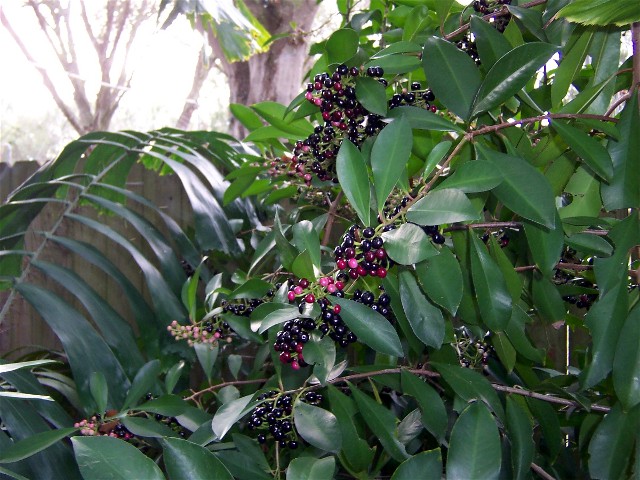
This plant is Coffee Cubensis , or in other words, Cuban Coffee. The plant mostly thrives in shaded conditions in central Florida due to its overgrowth quality. The coffee beans sprout quickly and easily like a weed, and grows like one too. It can easily survive both mild and extreme cold, short-term freezes.
The Seeds produce healthy crops of coffee beans in about a single year and have a strong aroma.
Warning: Unlike a red bean Arabica coffee, the black bean coffee plants are more of your cappuccino type coffees and are typically 15 times more potent per bean then your standard Maxwell House type coffee.
The palm leaf to the left of the coffee is a Puerto Rican Palm known as the Macaw Palm.
Mayotte Island Bismark

Sitting next to the Mayotte Island Bismark near the mailbox is one of five Caryota Laosensis (gigantic black trunk fishtail).
This palm is from Laos (near Vietnam and Cambodia), it is a smaller form of the Caryota Obtusa. The distinct difference from the other fishtail palms is that this one has a jet black trunk, and the way it holds its leaves makes the palm resemble a giant tree fern.
The Mayotte Island Bismark Palm Treecan reach above 25 meter.
Key Features:
A trunk that looks “painted black”
Leaves with fish-tail-shaped leaflets (characteristic of Caryota)
A compact crown compared to taller fishtail palms
This palm sprouted from seed in 2001 and is already growing 12-foot-long leaves by 2025. The leaves are expected to grow as long as 45 feet each, with an approximate 3-foot diameter trunk. This is one of the largest palm species on earth, and this type of fishtail can cast shade similar to a large oak tree.
“Bismarckia is a monotypic genus of flowering plant in the palm family endemic to western and northern Madagascar, where they grow in open grassland.”
Sago Type Palms – Mayotte Island Bismarck Palm Tree
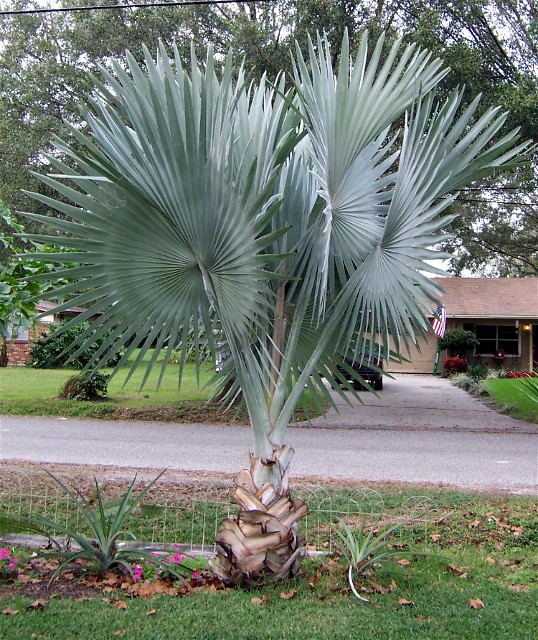
There are actually in fact over 110 different species of palm trees and cycads (Sago type palms). Here are a few of the more notable species that are visible to guests of the Christmas Light Walk Thru Trail.
The palm above is a Mayotte Island Bismarck Palm Tree. This is a very new introduction to South Florida, but it is now very popular among new homes for its privacy features.
Virtually all of the Bismarckia available from the Nursery Trade in Florida are not Mayotte Bismarck but are, in fact, from Madagascar.
The distinct difference between the Mayotte Island Bismarck and the Madagascar is that the Mayotte Island Bismarck appears to be larger and faster-growing in Florida than the ones from Madagascar.
An example can be seen at the front line of the lot, in there are 2 smaller Bismarcks that are from Madagascar. The Mayotte Island Bismarck near the mailbox is 1 year younger than Madagascar; however, the Mayotte Island is almost twice as big.
You can purchase Mayotte Island Bismarck Palm Tree here: https://smartyplantsnursery.com/product/bismarck-palm-bismarckia-nobilis/